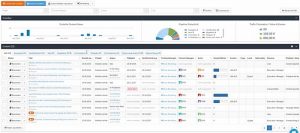
Freight management may seem like a straightforward process of moving packages from point A to point B in theory, but in practice, it can be a highly involved operation that requires a great deal of business strategy on behalf of retailers. The procedure is a key interaction point with consumers, and how goods go from warehouse to customers’ doorsteps has a direct impact on brand perception. Over time, a company’s freight management strategy can generate lifetime customer loyalty, or conversely, cause disdain and negative consumer perception of your brand.
According to Forrester, online shopping is expected to breach $ 327 billion this year, accounting for 9% of all retail sales. But the sale is just the first step in the important process of getting the right product to the right customer at the right time. Just like a company’s website or storefront, shipping is a key customer touchpoint –– and time efficiency matters.
To develop a quality freight management strategy, begin by asking yourself or your shipping strategist the following questions. Think through exactly how your end-customer experience should be, how far you can stretch your margins and if you can begin to count free shipping fees as a marketing expense to garner customer loyalty and increase your bottom line in the long run.
What is my ideal brand experience?
The way in which packages arrive at shoppers’ doorsteps says a great deal about how brands feel about their customers. For example, a damaged box that shows up three days late isn’t going to send a great message to shoppers in regards to your customer service. And, these days, customer service and subsequent customer perception can make or break your brand.
A trackable package, however, that arrives on time and perhaps even requires a signature at the door sends a message of quality and professionalism to customers –– increasing their trust in your brand and therefore the likelihood they will shop with you again.
Because a shipment is one of the only physical touchpoints an ecommerce brand has with its customers, timeliness and packaging material or design are factors that all brands should be taking the time to explore. Sure, you already got them to convert, but if you want them to continue purchasing from your brand, if you want to increase their customer lifetime value, then you have to nail the shipping –– both aesthetically and time-consciously.
Of course, not all brands can afford a luxury shipping experience, and frankly not all customers demand premium delivery. It’s important to instead align freight decisions with an intended brand experience. High-end brands may want to invest in better packaging processes. Even just the packaging material can matter: 61% of online shoppers say premium packaging makes a brand seem more upscale. For retailers with a more general target audience, invest in branded packaging or even just branded packaging notes encouraging users to share their experience of your product with the world. This adds a personal touch to the package without needing to increase expenses. Even a handwritten note can suffice here.
When companies begin to understand their customer’s desires and expectations, they can begin to make more informed freight decisions that meet those demands.
How much is my average order value (AOV) for shipping?
The AOV of packages is another metric brands can use to define their shipping strategies. The basic rule to follow is:
As AOV increases, investments in shipping methods should increase, too.
For instance, the AOV for office supplies like pens and pencils is typically under $ 100. As such, shoppers are not likely to be concerned with being able to track their package, or if their package is delivered without needing a signature. On the other hand, consumers ordering pricey electronics (with AOVs in the thousands) expect their goods to arrive in pristine condition. The more expensive the purchase or the value of the purchase, the more time you need to spend with setting up a strategic freight shipping strategy.
As AOV increases, brands should invest in greater insurance measures. This can include careful handling procedures or sturdier boxes. Additions like these give consumers peace of mind that their products are safe and makes them feel that their money is well spent.
Can I afford to offer free shipping?
Free shipping is a powerful tool for online retailers. In fact, 47% of all online orders now include free shipping and studies show shoppers spend 30% more with companies offering free shipping. But getting free shipping up and running can a be a difficult, margin-cutting task.
Many scaling brands simply cannot afford to offer free shipping on every order, but that doesn’t mean you should forgo free shipping altogether. Promotions can be used as a powerful marketing tool. For example, a free shipping threshold can be the final conversion persuasion point on high-ticket items and can increase your overall AOV. The tool can complement a wide variety of marketing endeavors, like the promotion of a newsletter (free shipping upon subscription) or the growth of sales during holiday seasons.
No matter how it’s used, free shipping should always benefit a brand’s bottom line. Like any good marketing strategy, measure, test and analyze your free shipping offering to ensure it is producing ROI. A/B testing your offerings on your site is a good way to do this. Also, pay close attention to critical factors like customer location and the size and weight of products, as these can alter when free shipping is a logical option. Free shipping involves many business verticals from logistics to marketing, but when done correctly it can drive sales, which in turn generates greater revenue.
Putting it All Together
Freight management is a key aspect in how shipments arrive at shopper’s home. Once you have determined exactly how your shipping experience should be for your end-customer, it’s time to find a freight management partner to help you accomplish those goals. Here are some tips:
- Ensure consistency on charges: While there are many variables that go into determining the cost of shipping, it is very important to analyze freight costs to make sure there is a level of consistency. Some cost components are going to always vary geographically, but others should remain constant. It is very important to lock-in the rates at time of contract with freight providers. For example, the price invoiced for container #53 should be the same as container #1, regardless of the time frame between shipments. This requires excellent communication skills on the business’s part. Set firm boundaries. Any unexpected change in fees should have a 30 to 60 day alert period –– otherwise be sure to contractually agree that you can break the contract terms in the case this does not occur. Frequently changing fees cut into your bottom line at one of the most critical intersections of your operation.
- Be location aware: When thinking about business opportunities and expansion, keep your location in mind and check in with freight management companies to talk about negotiated rates for various warehouse locations. You can use an integration like ShipperHQ to help you show real-time shipping rates to customers based on your negotiated rates, so there are no surprise fees for your customers either.
- Communication is key: Ensure all details concerning the freight are given to the freight management services provider, as they will have a chance to give you a service to better match the needs you have, connecting you with the right carrier to handle any of the specific shipping conditions you may have. Use freight management consultation and analysis services, as well, to see where you could be cutting costs –– and then negotiate. Many transportation management services providers can give you a solution that best matches what you need in order to reach your goals and necessary margins. Going into the partnership with clear goals, expectations and boundaries upfront yields great long term and sustainable bottom line savings.
- Air vs. ocean for international projects: For a successful international project, it is important to partner with a freight forwarder that can provide both air and ocean freight services. Regardless of how well you plan your freight, anything can go wrong. Inevitably, air shipments will need to be implemented for that key component that failed at startup or that was “misplaced” in transit. It always happens. Freight providers can typically schedule a pallet load air shipment anywhere in the world within five days at very reasonable rates. Ask about it.
- Tracking both domestically and internationally: Something we take for granted in domestic freight is the ability to track shipments door to door. It is an absolute must to always know, or at least have the ability to quickly determine, where your freight is at any moment. Mandate that your freight partners have the ability to provide real time status of all freight with a simple phone call or via a few mouse clicks. This is vital for international projects where delays in port can quickly add up to big dollars, as the industry saw in 2015.
- Quality assurance: Whenever you work with a professional transportation management 3PL, they will look after your interests. After all, you as a client are the lifeblood of their company. A good services provider will align themselves with other transportation companies to provide the best service they can in the long run, but you need to be able to ask them a few questions to check and understand their quality control procedures. You need to know whether they have a quality assurance program, the condition of their business practice and its maintenance, whether they have control checks in case of anomalous events and contingencies to ensure your freight arrives on time and safe and more. A disaster recovery plan should also be a part of the way they operate to ensure all bases are covered when you work with them.
- Do your due diligence: Ask for client-like-me references and then actually call those brands. Ask about their experience with the company, what they would have done differently if they could go back and use the power of knowledge and reference to find the best partner for your company and to negotiate the best rates for your packaging and shipping needs.
Have any tips or questions about freight management best practices and strategies? Leave them in the comments below.
Business & Finance Articles on Business 2 Community(43)









